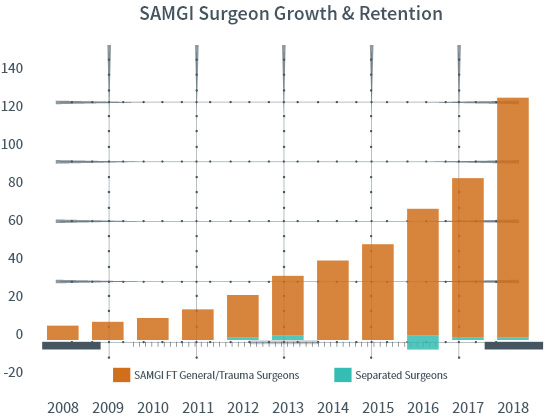SAMGI’s scalable surgicalist programs improve patient care and outcomes by helping hospitals close gaps in emergency surgical care. Our local board-certified surgeons and dedicated support team deliver 24/7/365 emergency surgery care and have no competing duties while on service. As a result, emergency patients at our partner hospitals undergo surgery without delays. This leads to better outcomes for patients and improved performance for hospitals.

emergency surgical
care
services across the U.S. are posing severe challenges to our hospitals.
With our evidence-based surgicalist program, your hospital has a surgeon and team onsite 24/7/365 to provide immediate care for emergency patients. Unlike locum tenens physicians, who fill staffing gaps on a temporary basis, SAMGI provides a long-term, high-quality local solution inside your hospital.
Our partner hospitals across the nation report increased patient throughput, improved efficiency, and fewer ED hurdles. SAMGI’s comprehensive, self-managed programs also help hospitals:
- Integrate a standardized emergency general surgical care program
- Eliminate costly call pay
- Provide the level of services required to become an ACS-verified trauma center
- Eliminate supply waste and workflow inefficiencies
- Collect accurate case documentation for optimum reimbursement rates
- Decrease care variations and optimize value-based purchasing
- Improve surgical team morale through a better work/life balance
- Improve operating margins and substantially grow your bottom line
Solutions to your surgical staffing challenges begin with a conversation. Let’s talk.

Peer reviewed study of surgicalist program
A five-year study of Sutter Medical Center, Sacramento, published in the
Journal of the American College of Surgeons, shows across-the-board
improvements with the help of SAMGI. Results include:
Nearly 2/3 of US physicians report feeling burned out (42%) depressed (15%) or both (14%).
To alleviate burnout, 56% of the physicians responding to the survey suggested fewer bureaucratic tasks and 39% suggested working fewer hours.
51% of physicians reported experiencing frequent or constant feelings of burnout in 2017, up from 40% in 2013.
SAMGI helps alleviate physician burnout. Our surgicalist programs support a predictable, full- or part-time scheduling alternative that allows surgeons to focus their efforts where they choose. The result: improved hospital workflow efficiencies and better patient outcomes for both elective and acute care surgical teams.

Testimonials
We believe every emergency patient deserves the highest possible level of care. SAMGI’s local surgical partners are guided by the high-quality, standardized care protocols of our surgicalist programs.
We manage the business side of the surgical practice, freeing our physicians to focus on delivering the highest quality of patient care. As a result, patients benefit from:
- Decreased time to consult, shorter length of stay, and time to operation
- Reduced complications and re-admissions
- Reduced risk of possible life-threatening errors
To further ensure quality care and increased efficiencies, a dedicated local medical director oversees your surgicalist program and serves as a responsive resource for your staff and administration.

Patient stats

Calculate how SAMGI can impact your hospital's bottom line
Average Annual ER Visits










